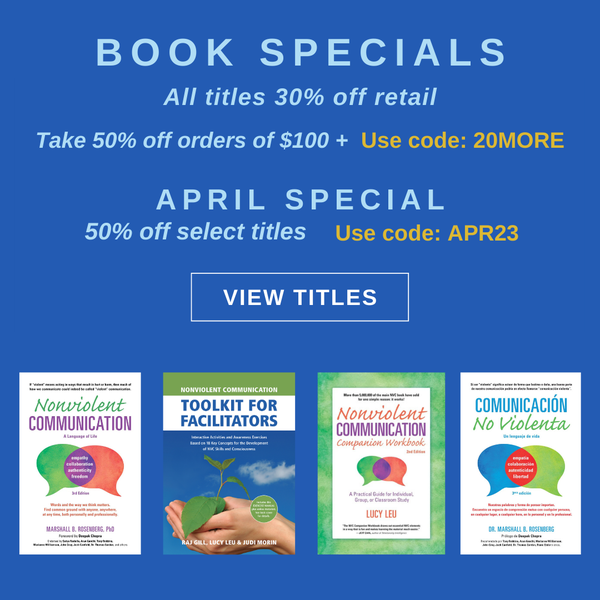|
|
|
|
NVC Monthly NewsletterApril 2023 |
We hope you find value in the resources we are providing today! We invite you to share with friends, family, colleagues, and others, if you believe they might also find value in this. Our most recently featured topic is written on ANGER. Our website covers over 35 different topics from an NVC perspective-all written by a senior certified trainer Alan Seid. Please read some to learn more. If you are new to Nonviolent Communication please visit our page on the basics of Nonviolent Communication. Please stay safe and healthy! Thank you :) PuddleDancer Press
What You'll Find in This Month's Newsletter:You may click any section header to jump to that section. (This feature is not supported on all devices or for all email clients.) - New Book! - The Heart of Nonviolent Communication
- The Compassion Course - Thom Bond
- A
Conversation with FirstGenNVCers - Event
- The Neuroscience of Trauma and Resilience - Workshop
- Nonviolent Communication for Anger
- Gateway to Spring by Rachelle Lamb
- Better Boundaries - How to Create Limits
with Love - Part 1 of 3
By Beth Banning
50% OFF both full Retail and eBooks Price - Nonviolent Communication: A Language
of Life
- Nonviolent
Communication Toolkit for Facilitators
- Nonviolent Communication Companion Workbook
- Comunicación no Violenta
- NVC Academy
- The Center for Nonviolent Communication Trainings
- NVC: A Language of Life - Chapter 1
- Nonviolent Communication Toolkit for Facilitators - Chapter 1
- Nonviolent Communication Companion Workbook - Chapter 1
- Comunicación no Violenta - Chapter 1
- Downloads
- Recommended Links
- Expressing the Depth of Our Anger
- Becoming a CNVC certified trainer
- Guidelines for Sharing NVC for Individuals who are not Certified Trainers
- Stand By Me | Playing For Change | Song Around The World
- NVC TIP SERIES (Free daily and weekly tips)
- FREE RESOURCES
- NVC FACEBOOK GROUPS
- NEW ** NVC LINKEDIN GROUPS **
NEW
|
New Title! - The Heart of Nonviolent Communication Now 30% off retail!
Do you want to express yourself honestly and compassionately? Learn to live in choice rather than submit or rebel? This book explores 25 key distinctions that reveal the consciousness embedded in Nonviolent Communication.
Drawing on brain science with awareness of systemic conditioning, each chapter presents examples from around the world alongside practices that will move you toward the spirit of true connection.
25 Key Distinctions - Life-Connected and Life-Disconnected Mindsets
- Value Judgments and Moralistic Judgments
- Interdependence and
Dependence/Independence
- Power-With and Power-Over
- Choice and Submission/Rebellion
- Observation and Observation Mixed With Evaluation
- Feelings and Feelings Mixed With Thoughts
- Needs and Strategies
- Requests and Demands
- Idiomatic Language and Classical(Formal) Language
- Being Giraffe and Doing Giraffe
- Empathy and Sympathy/Other Responses
- Empathic Sensing and Intellectual Guessing
- Self-Empathy and Acting Out, Repressing or Wallowing
- Giraffe Honesty and Jackal Honesty
- Protective and Punitive Use of Force
- Respect for Authority and Fear of Authority
- Self-Discipline and Obedience
- Natural and Habitual Ways of Being
- Vulnerability and Weakness
- Stimulus and Cause
- Persisting and Demanding
- Shift and Compromise
- Appreciation and
Approval/Compliments/Praise
- Love as a Feeling and Love as a Need
The Compassion Course with Thom Bond
"For anyone who wants to have more compassion, understanding and harmony in their lives and in our world” The 2023 Course Registration is now open.
Results you can expect from the course: - Experience more harmony and understanding with important people in your life
- Have less painful, shorter conflicts
- Have more awareness of your needs, wants and
desires
- Have your needs expressed and understood
- Increase congruence between your values and actions
- Translate judgments into dialogues & requests
- Increase harmony and understanding among others
- Stay more centered, open and effective in conflicts
A Conversation with FirstGenNVCers
The Neuroscience of Trauma and Resilience - Workshop
A Trauma-Informed school/workplace fosters an atmosphere of emotional and physical safety that can alleviate the effects of ACEs. Learn about: - The Neuroscience of Trauma
- Trauma Responsive Practices
- Impact of the ACEs on Children and Adults
- Creating Trauma-Sensitive Classrooms & Workplaces
- Alleviating the Effects of the ACEs
|
Nonviolent Communication for Anger |
Many people want to know how to use Nonviolent Communication for anger because it can be such a scary emotion for so many people. Feeling it, expressing it — and being on the receiving end of it — can be extremely unsettling! Nonviolent Communication (NVC) helps us navigate anger in a holistic way. Using NVC for anger is a healthy and empowering way to rewire our responses to this powerful emotion. Because anger is so often associated with violence, it’s common for people to avoid anger — as they might avoid conflict —
out of their need for safety...
Gateway to Spring by Rachelle Lamb
What do I do when my partner drives me crazy? How often do you find yourself asking that very question in a state of overwhelming exasperation? You're not alone! I've personally never met anyone who doesn't struggle with managing their distress during such moments. Some people are clearly better at managing than others though. Here's what's so interesting. We're often convinced that we want the quick fix,
the easy fix. Isn't that what we want? I think if we're really honest with ourselves though, our behaviour more often than not, reveals that we're more interested in getting what we want, or being right, during those wound up moments than we are in interrupting the escalation and calming down our own nervous system. The thinking often goes .. but I AM right!!! And yes, maybe you are. And there's also a good chance that you're both "right" .. that you each have a
different lens on the matter that will have its own variation of rightness. Trying to convince each other is rarely satisfying though and often only makes matters worse...
Better Boundaries - How to Create Limits with Love - Part 1 of 3 by Beth Banning
Does the pressure to please ever leave you feeling overwhelmed because you're constantly saying yes to everyone's requests? Or worry about saying no or asking for what you want because you might look selfish or don't care about anyone else? If so, it might be time to create some boundaries. However, I’m not talking about traditional boundaries. Instead, I want to give you an
alternative that will serve and support your life, feel good to create, and are easier to communicate to others. Plus, they’re also more satisfying for everyone involved. But first, it's essential to understand the roots of traditional boundaries and why an alternative is needed.... So let me tell you a little story… |
"Anger can be a wonderful wake-up call to help you understand what you need and what you value" Marshall Rosenberg |
"Anger is not the problem. It’s the thinking that’s going on in us when we're angry that’s the problem." Marshall Rosenberg |
NVC: A Language of Life - Chapter 1 |
Nonviolent Communication Toolkit for Facilitators - Chapter 1 |
Nonviolent Communication Companion Workbook - Chapter 1 |
Collaborating in the Workplace - Chapter 1 |
"Anger is a signal that your distracted by judgmental or punitive thinking, and that some precious need of yours is being ignored." Marshall
Rosenberg |
CNVC is committed to the vision of a critical mass of the world's population using Nonviolent Communication (NVC) to resolve differences peacefully. A strong community of qualified trainers will play an important role in the realization of this goal.
|
The NVC Academy offers hundreds of affordable online personal growth courses and resources to learn Nonviolent Communication from home.
|
The Center for Nonviolent Communication
The Center for Nonviolent Communication (CNVC) is a global organization that supports the learning and sharing of Nonviolent Communication (NVC), and helps people peacefully and effectively resolve conflicts in personal, organizational, and political settings.
|
"My anger is valuable. It’s really a blessing. When I'm angry I know I need to slow down, look at what I'm telling myself. Translate the judgments that are making me angry and get in touch with my needs." Marshall Rosenberg |
"When our full attention is on our needs, it’s impossible to be angry. No matter what the person is doing to you. You cannot be angry if your full attention is either on your need or the other persons need." Marshall Rosenberg |
Stay Connected to the Values of Compassion With the Free 365 Daily Peaceful Living Meditations.
Killing people is too superficial. —Marshall Rosenberg
Expressing the Depth of Our Anger Some people use hitting, yelling, name-calling, gossip, or other forms of abuse to express their anger. In the Compassionate Communication process, we see these expressions as ineffective, superficial ways of expressing anger. After all, what is accomplished by violence? Only retaliation. Repressing or “stuffing” our anger isn’t effective either, because we tend to carry the burden of
resentments with us. When our anger is not heard or resolved, we will not feel relief. Consider learning this new way to express your anger. It is more likely to bring you relief and resolution. Anger is created when we blame or judge someone else as bad or wrong, so the first step is to relieve the other person of the responsibility for our anger. We are responsible for our own feelings. The next step is to identify our unmet needs, such as support, caring, or
respect. The third step is to acknowledge our feelings, and the fourth step is to make a request, either of someone else or of ourselves. As an example, say that you are angry with your son for shaving your cat. Remember that anger starts with a judgment. In this case, you are probably thinking your son is insensitive, cruel, and self-centered. Your response may be to yell at your son. Rarely does such an approach bring relief or resolution. Your unmet needs might be
your values concerning caring for other living creatures, respect, and consideration for everyone’s needs. And you probably feel annoyed, angry, hurt, and scared. When you start to uncover your unmet needs, you will feel instant relief. If your pain is deep, you may start remembering other occasions when this need wasn’t met with your son or other people in your life. Each time a new memory pops into your head, acknowledge your unmet needs and feelings. When you
begin to notice a sense of relief, ask yourself what you can do to get your needs met in the present. It may be enough to simply acknowledge the needs yourself. Or you might want to make a request of your son or someone else. Once you have consciously connected to your unmet needs, you are more likely to make a request that will truly meet them. Be aware of how your anger is a result of blame or judgment of others; then connect to
your unmet needs in these situations and notice if you feel relief. |
- NVC TIP SERIES (Free daily and weekly tips)
- FREE RESOURCES
- NVC FACEBOOK PAGES
We hope you find value in our monthly newsletters. We would love to receive ANY feedback or suggestions you may want to share. Please let others know about our newsletter to help spread nonviolent communication, love, hope, humor and compassion, if you are willing :)
We want a more compassionate, equitable, peaceful, safe and healthy world.
Please be safe!
Warmly,
PuddleDancer Press
|
|
|
|
|
|
|
|
|
|











